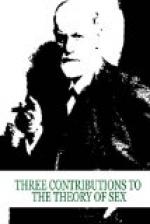Two Results.—In the study of perversions we have gained an insight into the fact that the sexual impulse has to struggle against certain psychic forces, resistances, among which shame and loathing are most prominent. We may presume that these forces are employed to confine the impulse within the accepted normal limits, and if they have become developed in the individual before the sexual impulse has attained its full strength, it is really they which have directed it in the course of development.[23]
We have furthermore remarked that some of the examined perversions can be comprehended only by assuming the union of many motives. If they are amenable to analysis—disintegration—they must be of a composite nature. This may give us a hint that the sexual impulse itself may not be something simple, that it may on the contrary be composed of many components which detach themselves to form perversions. Our clinical observation thus calls our attention to fusions which have lost their expression in the uniform normal behavior.
4. THE SEXUAL IMPULSE IN NEUROTICS
Psychoanalysis.—A proper contribution to the knowledge of the sexual impulse in persons who are at least related to the normal can be gained only from one source, and is accessible only by one definite path. There is only one way to obtain a thorough and unerring solution of problems in the sexual life of so-called psychoneurotics (hysteria, obsessions, the wrongly-named neurasthenia, and surely also dementia praecox, and paranoia), and that is by subjecting them to the psychoanalytic investigations propounded by J. Breuer and myself in 1893, which we called the “cathartic” treatment.
I must repeat what I have said in my published work, that these psychoneuroses, as far as my experience goes, are based on sexual motive powers. I do not mean that the energy of the sexual impulse merely contributes to the forces supporting the morbid manifestations (symptoms), but I wish distinctly to maintain that this supplies the only constant and the most important source of energy in the neurosis, so that the sexual life of such persons manifests itself either exclusively, preponderately, or partially in these symptoms. As I have already stated in different places, the symptoms are the sexual activities of the patient. The proof for this assertion I have obtained from the psychoanalysis of hysterics and other neurotics during a period of twenty years, the results of which I hope to give later in a detailed account.
Psychoanalysis removes the symptoms of hysteria on the supposition that they are the substitutes—the transcriptions as it were—for a series of emotionally accentuated psychic processes, wishes, and desires, to which a passage for their discharge through the conscious psychic activities has been cut off by a special process (repression). These thought formations which are restrained in the state of the unconscious strive for expression, that is,




